Intel SSD 520 Review: Cherryville Brings Reliability to SandForce
by Anand Lal Shimpi on February 6, 2012 11:00 AM ESTThe Intel SSD 520
Intel sent us a 240GB and 60GB SSD 520 for review, but the performance specs of the entire family are in the table below:
The Intel SSD 520 is available in both 9.5mm and 7mm versions, with the exception of the 480GB flavor that only comes in a 9.5mm chassis. The 520's uses Intel's standard 7mm chassis with a 2.5mm removable plastic adapter that we've seen since the X25-M G2. The plastic adapter allows the drive to fit in bays designed for 9.5mm drives. Note that Intel doesn't ship shorter screws with the 9.5mm drives so you can't just remove the plastic adapter and re-use the existing screws if your system only accepts a 7mm drive.
Inside the drive we see the oh-so-familiar SandForce SF-2281 controller and Intel 25nm MLC NAND. The controller revision appears unchanged from other SF drives we've seen over the past year. The PCB design is unique to the 520, making it and the custom Intel firmware the two noticeable differences between this and other SF-2281 drives.
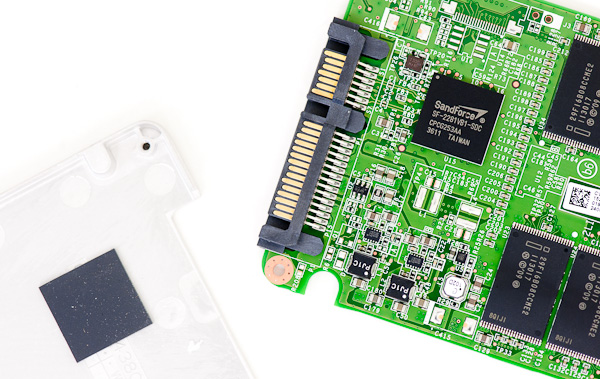
Intel uses the metal drive chassis as a heatsink for the SF-2281 controller
The SF-2281 Controller
I've explained how the SF-2281 works in the past, but for those of you who aren't familiar with the technology I'll provide a quick recap. Tracking the location of data written to an SSD ends up being one of the most difficult things a controller has to do. There are a number of requirements that must be met. Data can't be written to the same NAND cells too frequently and it should be spread out across as many different NAND die as possible (to improve performance). For large sequential transfers, meeting these (and other) requirements isn't difficult. Problems arise when you've got short bursts of random data that can't be combined. The end result is leaving the drive in a highly fragmented state that is suboptimal for achieving good performance.
You can get around the issue of tracking tons of data by simply not allowing small groups of data to be written. Track data at the block level, always requiring large writes, and your controller has a much easier job. Unfortunately block mapping results in very poor small file random write performance as we've seen in earlier architectures so this approach isn't very useful for anything outside of CF/SD cards for use in cameras.
A controller can rise to the challenge by having large amounts of cache (on-die and externally) to help deal with managing huge NAND mapping tables. Combine tons of fast storage with a fast controller and intelligent firmware and you've got a good chance of building a high performance SSD.
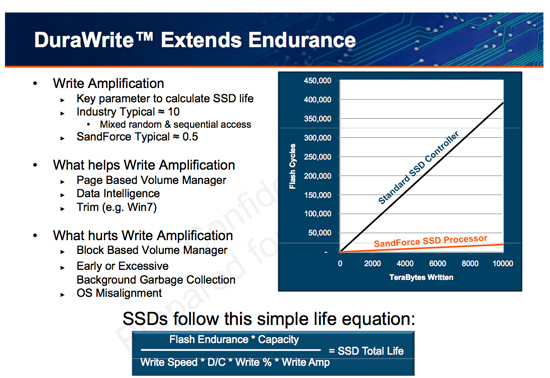
SandForce's solution leverages the work smart not hard philosophy. SF controllers reduce the amount of data that has to be tracked on NAND by compressing any data the host asks to write to the drive. From the host's perspective, the drive wrote everything that was asked of it, but from the SSD's perspective only the simplest representation of the data is stored on the drive. Running real-time compression/de-duplication algorithms in hardware isn't very difficult and the result is great performance for a majority of workloads (you can't really write faster than a controller that doesn't actually write all of the data to NAND). The only limit to SandForce's technology is that any data that can't be compressed (highly random bits or data that's already compressed) isn't written nearly as quickly.
Intel does a great job of spelling out the differences in performance depending on the type of data you write to the SSD 520, but it's something that customers of previous Intel SSDs haven't had to worry about. Most client users stand to benefit from SandForce's technology and it's actually very exciting for a lot of enterprise workloads as well, but you do need to pay attention to what you're going to be doing with the drive before deciding on it.
The Intel SSD Toolbox
The Intel SSD 520 works flawlessly with the latest version of Intel's SSD Toolbox. The toolbox allows you to secure erase the drive from within Windows, and it also allows you to perform firmware updates and pull SMART info from the drive. Unlike other SandForce toolboxes, Intel's software works fine with Intel's RST drivers installed.

The Test
| CPU | Intel Core i7 2600K running at 3.4GHz (Turbo & EIST Disabled) - for AT SB 2011, AS SSD & ATTO |
| Motherboard: | Intel DH67BL Motherboard |
| Chipset: | Intel H67 |
| Chipset Drivers: | Intel 9.1.1.1015 + Intel RST 10.2 |
| Memory: | Corsair Vengeance DDR3-1333 2 x 2GB (7-7-7-20) |
| Video Card: | eVGA GeForce GTX 285 |
| Video Drivers: | NVIDIA ForceWare 190.38 64-bit |
| Desktop Resolution: | 1920 x 1200 |
| OS: | Windows 7 x64 |


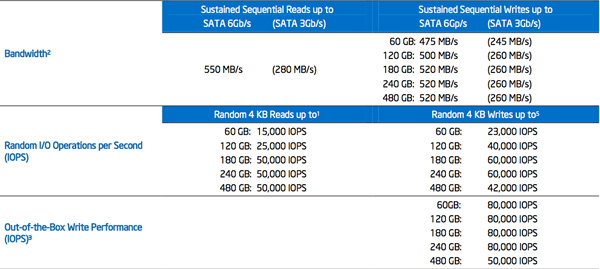
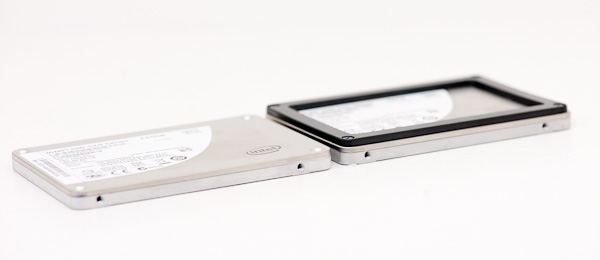






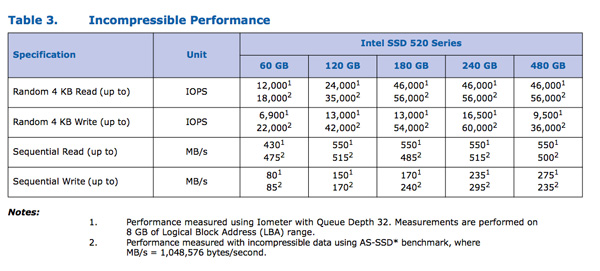












138 Comments
View All Comments
Iketh - Monday, February 6, 2012 - link
That price premium is doing me in, plus the irrecoverable drive thrashing. The 240gb Samsung will be my next purchase.Galcobar - Monday, February 6, 2012 - link
Find yourself having to ship a less reliable drive back to the manufacturer and the price premium disappears. At that point, not having to deal with the downtime and inconvenience of reinstallation is all gravy.Shadowmaster625 - Monday, February 6, 2012 - link
These drives are all built to pretty much the same physical quality standards. Firmware might be a different story, but for firmware it usually doesnt require a trip to the factory. Do you have any evidence to suggest that the physical build quality of an OCZ Vertex 2 is less than an Intel X-25?hackztor - Monday, February 6, 2012 - link
I had a vertex 1 that I had to ship back 4 times, finally I asked for a newer model. Got back the vertex 2. That right there is what Galcobar was talking about. Each time shipping is usually 10 bucks and about 2 weeks turn around time. Sometimes higher premium for better tested parts is worth the extra cost.pc_void - Monday, February 6, 2012 - link
The key word is sometimes.And sometimes you pay a higher price and have the same thing happen.
However, you can make an educated guess based upon lots of research. It still doesn't mean it won't happen.
Flunk - Monday, February 6, 2012 - link
I don't think firmware alone is responsible for the much lower failure rates of Intel SSDs over say... OCZ.I'm not saying other brands are bad, my Vertex 2 is still going strong with no issues, but these SSDs are built a little bit better than OCZ's drives and most of the other competition.
coder543 - Tuesday, February 7, 2012 - link
It's widely known that non-Intel SSDs have reliability issues. Recently they've gotten much better, but they still aren't yet comparable.taltamir - Monday, March 26, 2012 - link
The issue is that there are firmware bugs that intel fixed that sandforce and its other partners do not.You are right that there is no need to ship it back to the manufacturer... because they CANNOT fix it. A replacement drive will have the same bugs.
Your only recourse is to live with the bugs and BSODs or sell it second hand and buy an intel.
dmprok - Sunday, April 1, 2012 - link
I got Intel X-25 80Gb drive that failed on me TWICE in one year and I lost data. I picked Intel for TRIM function and because it was highly rated. First drive was purchased for $280 by my friend and it failed on him in 2 weeks, I thought he was doing something wrong, I bought dead drive from him and RMA'ed. It failed again for me in 6 months, one day computer just would not boot, I send it to RMA and got my 3rd drive, I hesitated to install for few months because I lost all faith in Intel SSD drives. I am not a heavy user, I don't run my PC 24/7, also the last drive drive I received does not look like quality made at all, the top of the drive is warped, I am disappointed, considering getting new Sandisk SSD for next upgrade.nsanity - Tuesday, February 7, 2012 - link
Having to ship a drive back means *absolutely nothing*. Hell, having to buy a complete new drive means nothing. The lost productivity when a business who has used a pair of SSD's as a shortcut to IOPS, as the machine BSOD's or drops an array till the system is physically powered off and on again simply dwarfs those costs.I'm a SMB Integrator and having to clean up after the mess of others who have used SF-2281 drives (Corsair Force 3 in particular) to achieve superior IOPS as opposed to using tried and true SAS arrays.
Random BSOD's and array's falling off a system is the plague i've seen with the SF-2281's. Firmware updates have really done nothing to help on the Corsair Drives.
On the Corsair Force 3 release, to enthusiast/gamer customers, I sold 3 drives, only to RA them 5 times within a month.
From that point I essentially told all my enthusiast customers that I would not sell them a Sandforce-based Drive, because I simply do not like unhappy customers, and nothing is more unhappy than someone bringing me a drive back within 48 hours.
I realise my sample size is small (Probably about 20-30 SSD's total), but I can tell you that out of the 15 Intel Drives I've seen/touched/supported (X-25M G2's, 320's and 510's), none of them have had any faults what so ever. Every, single, SF-2281 drive has had faults.
The advent of Intel making Sandforce based drives leaves me with very uneasy. Intel's reliability is second to none, but I need more than just an anecdotal review telling me that they've "fixed" the SF-2281. I've been burned on a small scale, and i've watched a fellow SMB integrator friend lose thousands of dollars in free labour trying to repair systems based on these drives.
I'm looking forward to Anand's part two, using these drives in an Enterprise scenario - and hopefully he's got a machine doing heavy load testing in the mean time to better report on the reliability- or otherwise of these drives.